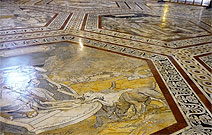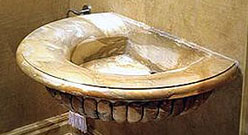 The use of crystalline limestones yellow, gray and white of the quarries of Montagnola is mainly linked to the construction of religious buildings.
The use of crystalline limestones yellow, gray and white of the quarries of Montagnola is mainly linked to the construction of religious buildings.
So we find the marble of Siena in the parishes of Montagnola (XI century) and, from the fourteenth century, in the city of Siena in the first place in the Cathedral of Siena, but also in other monumental buildings, such as the lining of the Lodges of Pope and the Lodges of Merchandise, as well as in works of art as the Fonte Gaia, fifteenth-century masterpiece by Jacopo della Quercia. In this period, the Marble Montagnola is also used in important architectural works of central Italy, such as Florence Cathedral and the Cathedral of Orvieto.
 The white varieties were used mainly as a building stone in square blocks, while the yellow varieties were used to make ornaments in the interior, such as the 1,300 square meters of colorful mosaics of the floor of the Duomo of Siena.
The white varieties were used mainly as a building stone in square blocks, while the yellow varieties were used to make ornaments in the interior, such as the 1,300 square meters of colorful mosaics of the floor of the Duomo of Siena.
A collection of "Specimens dei Marmi used dell'Opera del Duomo di Siena" and its quarries of origin is on display at the Natural History Museum of Siena, valuable source of information for the restoration and maintenance of the monument. In six to seven hundred are witnessing a certain decadence of the white varieties, due to the start of the import of Apuan marble characterized by a stronger structure, and therefore more resistant to weathering, and at the same time the success of the yellow varieties, so that in this period occurs the development of all areas of cultivation of Giallo di Siena. In fact, the Grand Dukes of Tuscany promote a genuine policy of self-sufficiency of the stones, and the Giallo di Siena is widely used by the Florentine manufacture Opificio delle Pietre Dure for making architectural decorations, pieces of furniture and precious objects.
Still today the mining of marble yellow, gray and white, in part worked in the area, where artisans enhance the natural beauty of a unique product of its kind.
 Among the most important works we can mention the hundred columns of Giallo Siena for the palace of Siam, the tiles of the floor of the hall Astrea of the Royal Palace, the 4,000 square meters of slabs for the lining of the basilica of St. John Bosco in Rome, as well as the interior of the Casino of San Remo and boardrooms in the new headquarters of the Bank of Italy, but also, more simply, items for home furnishings (tables, sinks, jars) and places of worship (altars sources baptismal).
Among the most important works we can mention the hundred columns of Giallo Siena for the palace of Siam, the tiles of the floor of the hall Astrea of the Royal Palace, the 4,000 square meters of slabs for the lining of the basilica of St. John Bosco in Rome, as well as the interior of the Casino of San Remo and boardrooms in the new headquarters of the Bank of Italy, but also, more simply, items for home furnishings (tables, sinks, jars) and places of worship (altars sources baptismal).
 Thanks to innovative techniques of pre-consolidation that improve its workability, the Sienese marble lends itself today in a virtually unlimited range of machining and finishing treatments that include etching techniques and tunnel extremely complex. Thus, the Giallo di Siena is an alternative viable material for your project of contemporary architecture and is one of the most valuable resources of the rich world lithological Tuscan.
Thanks to innovative techniques of pre-consolidation that improve its workability, the Sienese marble lends itself today in a virtually unlimited range of machining and finishing treatments that include etching techniques and tunnel extremely complex. Thus, the Giallo di Siena is an alternative viable material for your project of contemporary architecture and is one of the most valuable resources of the rich world lithological Tuscan.